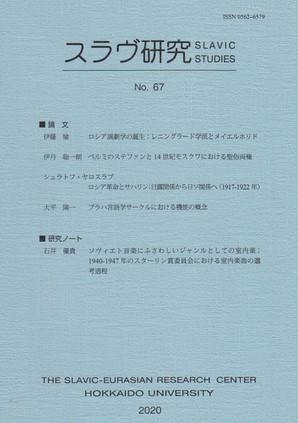ロシア革命とサハリン ― 日露関係から日ソ関係へ(1917-1922 年)―
The Russian Revolution and the Issue of Sakhalin: Transition From Russo-Japanese to Soviet-Japanese Relations (1917-1922)
Author(s): Yaroslav ShulatovSubject(s): Diplomatic history, Military history, Political history, Government/Political systems, International relations/trade, Comparative politics, Pre-WW I & WW I (1900 -1919), Interwar Period (1920 - 1939), Geopolitics
Published by: Slavic Research Center
Keywords: Russian Revolution; Issue of Sakhalin; from Russo-Japanese to Soviet-Japanese relations; 1917-1922; History of relations; Political history;
Summary/Abstract: Sakhalin occupies a special place in the history of relations between Russia and Japan. Depending on the times, the island has been a battlefield or a place for cooperation; the rivalry over Sakhalin was often an agenda-setting factor for bilateral relations. The island could be set as a sort of “crossroad,” where Russia and Japan interacted variously; a “mirror,” reflecting the condition of Russo-Japanese contact. The situation over Sakhalin was particularly dynamic in the first half of the twentieth century. The island became the last battlefield in the Russo-Japanese War, and then the final crucial problem at the peace conference. According to the Portsmouth Peace Treaty, Sakhalin was divided between the two empires, which created a precedent of revising the Russo-Japanese borderline with military force—since 1905, it has been changed only by wars. Still, the demarcation of a new border took place in a peaceful atmosphere, symbolizing the cooperative trend in the bilateral relations after the war. The situation seemed to have been resolved. Yet the collapse of the Russian Empire in 1917 rendered Sakhalin the subject of Russo-Japanese bargaining again. Then, with the outbreak of civil war in Russia, Japan took an active part in intervention, deploying the largest contingent of troops to Siberia and the Far East. The center of Sakhalin Oblast, Nikolaevsk, was occupied by Japanese troops in 1918. After the clashes with partisans and annihilation of the Japanese garrison and its inhabitants in 1920 (the “Nikolaevsk Incident”), Japan occupied Northern Sakhalin, making it the hostage of settlement with Russia. After the USSR was established and Soviet-Japanese negotiations launched officially, Sakhalin became the key problem, particularly at the final stage. After reaching a compromise on this issue, the Peking Convention was signed in 1925. A new “Soviet” Russia repossessed Northern Sakhalin, and the USSR was officially acknowledged by Japan, which carved out concession rights for Sakhalin oil and coal, effective until 1944. These events became the subject of attention by many prominent scholars, including John Stephan, Teruyuki Hara, Takashi Murakami, Naoki Amano, etc. However, mostly due to lack of archival sources, the period of 1917-1922 remains insufficiently researched, particularly from the viewpoint of diplomatic history. What place did Sakhalin occupy in the negotiations between Japan and its Russian counter-partners, especially given the enormous dynamics of changes and diversity of political actors involved? This article analyzes the role and evolution of the Sakhalin issue in Russo-Japanese relations after the collapse of the Russian Empire in February 1917 to the establishing of the USSR in late 1922. The author conducts multi-archival research and examines the position of the provisional government, the Kolchak administration, Russian military circles, and local authorities, as well as the Bolsheviks and Soviet officials in Moscow and the Far East, providing analysis of the complicated “mosaic” over Sakhalin in Russo/Soviet relations during the abovementioned period. The article uses various declassified files mostly from Russian archives (AVP RI, AFP RF, RGIA, and RGASPI), as well as materials of the Diplomatic Archives of the Ministry of Foreign Affairs of Japan (Gaimushō Gaikō Shiryōkan) and published documental collections. The issue of Sakhalin appeared on the table of negotiations with Japan soon after the February Revolution. Japan worried about the US involvement in developing the island’s resources, and encouraged the provisional government to exclude American capital and provide the Japanese with prerogatives, but Petrograd was reluctant to do so. The Russian military also took a cautious stance towards Japan, suspecting it of using Russia’s weakening position and expanding its influence over her eastern territories including Sakhalin.
Journal: Slavic Studies
- Issue Year: 2020
- Issue No: 67
- Page Range: 59-82
- Page Count: 24
- Language: Japanese

